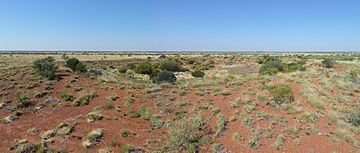Veevers crater facts for kids

Veevers Meteorite Crater, August 2011
|
|
| Impact crater/structure | |
|---|---|
| Confidence | Confirmed |
| Diameter | 80 m (260 ft) |
| Age | <1 Ma Pleistocene |
| Exposed | Yes |
| Drilled | No |
| Bolide type | iron meteorite (IIAB) |
| Location | |
| Location | Great Sandy & Gibson Deserts |
| Coordinates | 22°58′12″S 125°22′21″E / 22.97°S 125.3725°E |
| Country | Australia |
| State | Western Australia |
The Veevers crater is a special hole in the ground made by a meteorite hitting Earth. It's found in a flat, sandy area in the middle of Western Australia. This spot is very far away from cities, making it hard to visit.
Scientists first found the crater from an airplane in July 1975. They were doing a survey of the land. They named it after John Veevers, an Australian geologist who had worked in that area. At first, they thought a meteorite made it, but they couldn't be sure. Later, in 1984, scientists E.M. and C.S. Shoemaker found pieces of an iron meteorite around the crater. This proved that a space rock had indeed crashed there!
Contents
What Does Veevers Crater Look Like?
The Veevers crater is shaped like a perfect bowl. It's one of the best-preserved small meteorite craters on Earth. Imagine a giant, smooth dent in the ground!
How Big Is the Crater?
The edge, or rim, of the crater is about 20 meters (65 feet) wide. It rises about 1.5 meters (5 feet) above the flat desert ground. The deepest part of the crater is about 7 meters (23 feet) below the rim. From one side of the rim to the other, the crater is about 70 meters (230 feet) across.
How Old Is the Crater?
Scientists have studied the crater walls to figure out its age. They believe the crater is less than 20,000 years old. Some even think it might be less than 4,000 years old! This makes it quite young in Earth's history. Its fresh look suggests it hasn't been around for too long.
The Meteorite That Made It
The pieces of iron meteorite found around the crater are very interesting. They are a type called coarse octahedrite and belong to a group known as IIAB. These meteorite pieces show signs of being squashed and changed. This happened during the huge explosion when the meteorite hit the ground.
Scientists think the original meteorite was very heavy, weighing between 100 and 1,000 tons! Most of this meteorite broke into tiny pieces. These pieces are now mixed into the rocks and dirt inside and around the crater.


